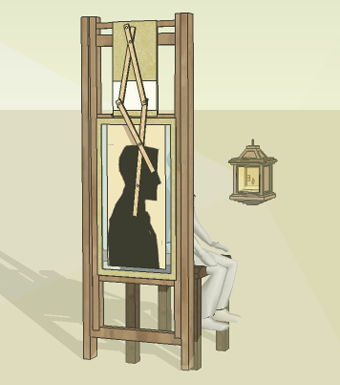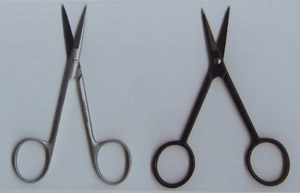Silhouette methods - cut from paper or card
Cutting from paper or card is one of the oldest techniques for creating silhouettes and remains popular with modern artists. However, techniques have developed since the first simple examples were produced during the mid-18th century.
There are two different cutting methods. Traditionally, using the ‘standard-cut’ technique, the outside of a sheet is pared away, to leave the finished portrait, as is shown in the sequence of images immediately below.

Alternatively, an artist can make a ‘hollow-cut’, which sees the centre of a sheet removed to produce the portrait, as is shown in the three photographs below.

One of the greatest challenges facing early cutters was the unavailability of black paper. Pre-died black paper was not produced until 1826, so early artists were faced with the challenge of ‘blackening’ sheets of white paper. A number of materials were used, including lamp black and burnt animal bones, with varying degrees of success. It is thought to be the difficulty of accessing black paper that brought about the ‘hollow cut’ method. In this technique the silhouette was cut out of white paper, with the outline of the portrait left in the centre of the page. The paper was then placed over black cloth, or other dark media, to create the silhouette.
The mass availability of pre-dyed black paper revolutionised the silhouette industry. Production became much quicker and costs dramatically reduced, ensuring the continuing popularity of the trade. By the 1840s paper in a variety of colours was available to complement the black, from greys and browns to deep red and pink. Today, cutters use a wide variety of surface textured and coloured papers.
 Many late-18th and early-19th century cutters would have used a machine to trace the outline of the sitter’s profile before cutting. These came in various configurations, including ‘shadowgraphs’, an example of which is shown in the picture to the left, and the rather fantastical contraptions known as a ‘physiognotraces’, the latter being designed to capture a sitter’s profile ‘automatically’ via the passing of a rod over their face while a pencil attached to the other end of the rod traced their features.
Many late-18th and early-19th century cutters would have used a machine to trace the outline of the sitter’s profile before cutting. These came in various configurations, including ‘shadowgraphs’, an example of which is shown in the picture to the left, and the rather fantastical contraptions known as a ‘physiognotraces’, the latter being designed to capture a sitter’s profile ‘automatically’ via the passing of a rod over their face while a pencil attached to the other end of the rod traced their features.
Some machines could make portraits of various sizes, others only produced life-sized outlines. In this case, an artist could reduce the size of a portrait using either a simple grid, or a quicker-to-use pantograph; a parallelogram-shaped tool designed for scaling images. The image to the left shows a sketch of a shadowgraph silhouette machine with inbuilt pantograph. Today most cutters sketch the profile before working freehand with scissors, but some experts can produce both standard-cut and hollow-cut work without first sketching an outline.
 Before the 1760s, knives would have been widely used to cut silhouettes, as scissors were hand made and expensive. Mass production techniques led to scissors becoming widely available from 1761, and they have since been the tool of choice for cutters. Modern artists tend to favour surgical or sewing scissors, and the very best can achieve fluid shapes and fine details simply with cut lines. The photograph to the left illustrates two pairs of modern scissors suitable for cutting silhouettes. The pair to the left are left-handed stainless steel 'iris' scissors, the pair to the right, standard right-handed scissors.
Before the 1760s, knives would have been widely used to cut silhouettes, as scissors were hand made and expensive. Mass production techniques led to scissors becoming widely available from 1761, and they have since been the tool of choice for cutters. Modern artists tend to favour surgical or sewing scissors, and the very best can achieve fluid shapes and fine details simply with cut lines. The photograph to the left illustrates two pairs of modern scissors suitable for cutting silhouettes. The pair to the left are left-handed stainless steel 'iris' scissors, the pair to the right, standard right-handed scissors.
